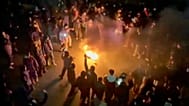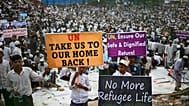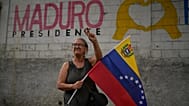Before live streaming the shooting in two New Zealand mosques on Facebook, the suspect published an apparent manifesto in which he called immigrants “invaders” and cited “white genocide” as his motivation for the attack.
A 28-year-old suspect has been charged with murder after 49 people were killed and dozens were injured in mass shootings at two New Zealand mosques during Friday prayers.
Police sources confirmed to Euronews’s partner NBC News that the suspect's name is Brenton Tarrant, a personal trainer from the northern New South Wales city of Grafton, who they described as a "right-wing extremist terrorist."
But how what was behind his motive?
Before allegedly live streaming the attack on Facebook, the suspect published an apparent "manifesto" in which he denounced immigrants as "invaders".
The 74-page document, a collection of slogans and tirades against immigrants, Muslims, and Jews posted on the chat forum 8chan — known for publishing a wide range of content including hate speech — cited “white genocide” and the growth of minority populations as his motivation.
The author described himself as an ordinary white man born into a working-class-low-income family with Scottish, Irish, and English origins.
After losing his father, Tarrant used the money he earned to travel and visited very different places where a white Australian was a minority.
During his travels, Tarrant claimed he had brief contact with the Norwegian mass murderer Anders Breivik, who gave his blessing to the attack.
In the document, the attacker, who described himself as a "racist" and saw US President Donald Trump as a "symbol of renewed white identity," believed the conflict over the 2nd amendment in the US (the right to bear arms) would result in a civil war.
The manifesto revealed that the attacker moved to New Zealand to stage the alleged attack, which he had been planning for two years.
The suspect also claimed Emmanuel Macron's victory over Marie Le Pen in France's 2017 presidential played a crucial part in his radicalisation.
But Tarrant also praised the Internet for teaching him and helping him develop his "beliefs". In fact, his worldviews seem to be put together by pieces he found on the world wide web. The document also indicates a heavy involvement in online subcultures that attract extremist views.
Nolwenn Bervas, lead terrorism analyst at the Risk Advisory Group, told Reuters there were numerous places around the internet for people such as the Christchurch attacker to congregate.
"The amount of information and propaganda linked to the far-right, far-left or jihadism is extensive and accessible," Bervas said. "One of the Christchurch perpetrators posted his manifesto online before the attack where he wrote that he received/researched/developed his beliefs on the Internet, adding 'You will not find the truth anywhere else'. He cited people like Dylan Roof or Anders Breivik as inspirations, who also researched and developed their beliefs online."















